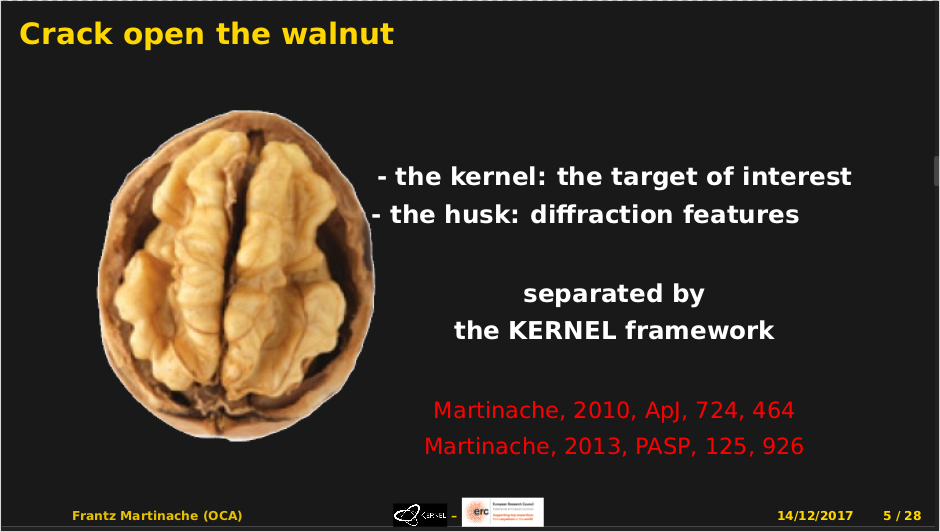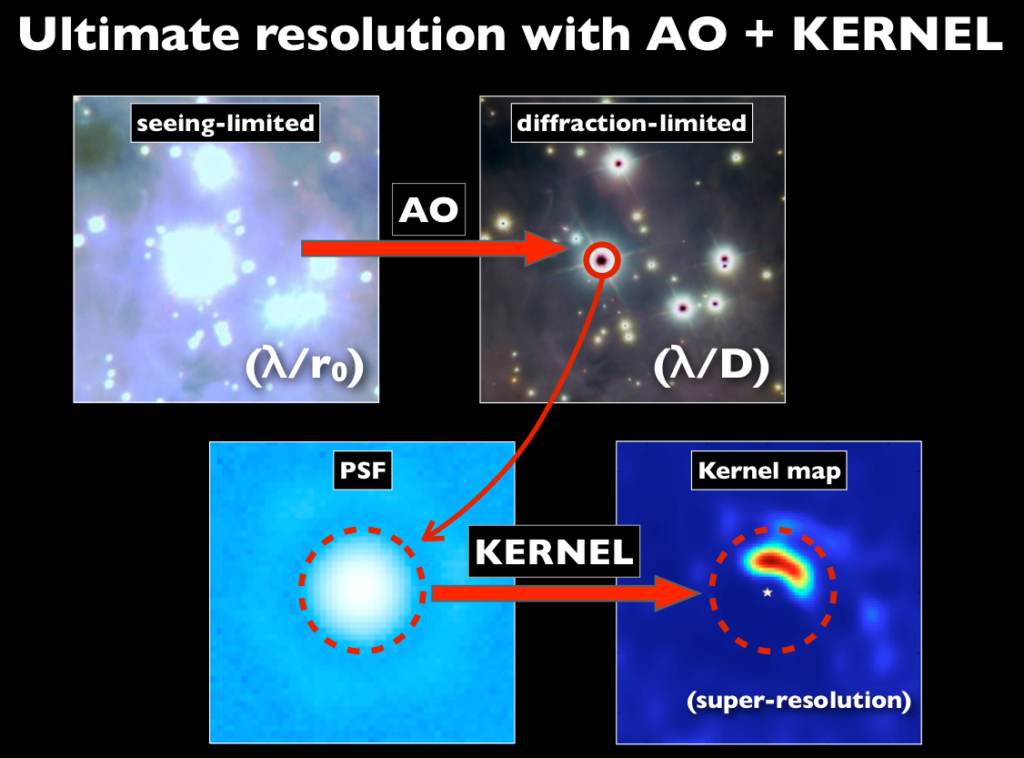Presentation slides of a seminar given at Mt. Stromlo Observatory, in Canberra, Australia.

 Because of the exquisite level of wavefront control they enable, extreme adaptive optics (XAO)-fed instruments like SPHERE at VLT or SCExAO at the Subaru Telescope, have led to discovering new subtle effects that were previously invisible, as images were still dominated by the lesser correction. One such recently discovered effect is the “low wind effect” (LWE), so called because its impact is particularly obvious when the low altitude wind speed decreases below a threshold speed: whereas such observing conditions should in theory be ideal for the instrument, the image quality decreases so much that the instrument cannot be used productively.
Because of the exquisite level of wavefront control they enable, extreme adaptive optics (XAO)-fed instruments like SPHERE at VLT or SCExAO at the Subaru Telescope, have led to discovering new subtle effects that were previously invisible, as images were still dominated by the lesser correction. One such recently discovered effect is the “low wind effect” (LWE), so called because its impact is particularly obvious when the low altitude wind speed decreases below a threshold speed: whereas such observing conditions should in theory be ideal for the instrument, the image quality decreases so much that the instrument cannot be used productively.
This effect seems to be due to subtle interactions of the airflow and the structure bearing the secondary mirror of the telescope: when the wind speed drops, temperature gradients occur over the surface of the primary, and result in strong aberrations and even discontinuities in the wavefront that are very difficult to diagnose by conventional wavefront sensors. Given that the signature of the effect is particularly strong on the image (the resulting PSF was even nicknamed “Mickey Mouse”, since it sometimes bears strong sidelobes reminiscent of the famous mouse’s ears), the image seems like the right place to diagnose this effect: an ideal job for the phase transfer model at the heart of the KERNEL project!
Given prior experience with focal plane based wavefront sensing (reported in a publication available here) with the SCExAO instrument, the KERNEL team is investigating the relevance of the asymmetric pupil Fourier wavefront sensing (APF-WFS) technique, and its ability to account for the peculiar aberrations introduced by this LWE. The video below features a proof of concept: it shows that, at least in the context of a simulation, the technique can indeed be used in a closed-loop system, to bring these aberrations down! This adaptation of the APF-WFS to deal with the low wind effect will be the object of experimental work at the Subaru Telescope, over the next couple of weeks.
 One of the pillars on which the KERNEL project rests is a data processing pipeline that aims at being as versatile and portable as possible, for general astrophysics purposes as well as for metrology. The maintenance of this tool is one of the tasks listed among the work packages that make up the bulk of the KERNEL project. Since the idea is to make the pipeline available to the community at large, it was decided to host the source code on an open access repository on GitHub. The new package is called XARA, an acronym that stands for eXtreme Angular Resolution Astronomy, and can be downloaded right here. This package is an evolution of a previous incarnation called PYSCO (Python Self-Calibrating Observables), that was hosted on the now defunct Google Code platform. The most notable difference is that it is properly packaged and can be installed, so that its classes and functions can be called from anywhere in your python scripts.
One of the pillars on which the KERNEL project rests is a data processing pipeline that aims at being as versatile and portable as possible, for general astrophysics purposes as well as for metrology. The maintenance of this tool is one of the tasks listed among the work packages that make up the bulk of the KERNEL project. Since the idea is to make the pipeline available to the community at large, it was decided to host the source code on an open access repository on GitHub. The new package is called XARA, an acronym that stands for eXtreme Angular Resolution Astronomy, and can be downloaded right here. This package is an evolution of a previous incarnation called PYSCO (Python Self-Calibrating Observables), that was hosted on the now defunct Google Code platform. The most notable difference is that it is properly packaged and can be installed, so that its classes and functions can be called from anywhere in your python scripts.
It is accompanied by a convenient simulation package of eXtreme Adaptive Optics (XAO) astutely called XAOSIM and also made available on GitHub. Keep in mind that both are work in progress, that will be regularly updated over the course of the KERNEL project, as features are added and bugs are accounted for, so always check for the latest update of these tools before using them!
Every good project needs a good logo. KERNEL now therefore has one: it was realized by my brother, Wilfried Martinache, who’s training to become a professional graphic designer. Check out his website: thebigbluebear.net. I think the logo is pretty neat, as it suggests that the stuff that really matters, at the heart of things (ie. the kernel!), may be invisible although it influences everything around it!




Combined with adaptive optics (AO), a kernel-phase data analysis makes it possible to further improve our understanding of astronomical images, and bypass the generally accepted limit of angular resolution, imposed by the theory of diffraction. This is sometimes refered to as “super-resolution”.
Astronomy requires large telescopes to improve the sensitivity and the angular resolution of its observations. Of these qualities, angular resolution is the most difficult to maintain in the optical and near-infrared, since the atmosphere reduces it to that of a 10 cm aperture, regardless of the telescope size. On the one-hand, Adaptive Optics (AO) actively compensates for this effect but the improvement is often partial only. On the other hand, interferometric techniques (most notably sparse aperture masking interferometry) passively allow the extraction of self-calibrating observables, that boost the angular resolution, but severely affect the sensitivity of observations.
The KERNEL project will enable every optical telescope equiped with AO to reach its ultimate angular resolution potential at full sensitivity, using a Fourier-phase framework, with applications ranging from the reinterpretation of archival science data to the development of wavefront control strategies for the giant segmented aperture of large telescopes like the space-borne JWST, or the upcoming generation of ground based extremely large telescope (ELTs).
KERNEL will achieve this objectives thanks to:
That will require the combined development of:
The consequences of this project will have a major impact on the design and scientific exploitation of future high angular resolution instrumentation on the existing generation of 8-10 meter class telescopes as well as on the upcoming generation of 30-40 meter giants, championned by Europe and its E-ELT.